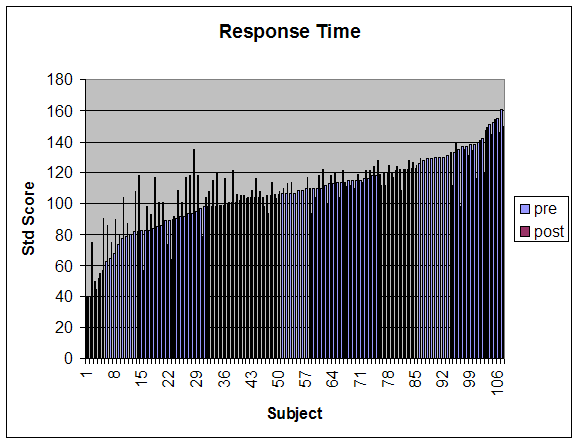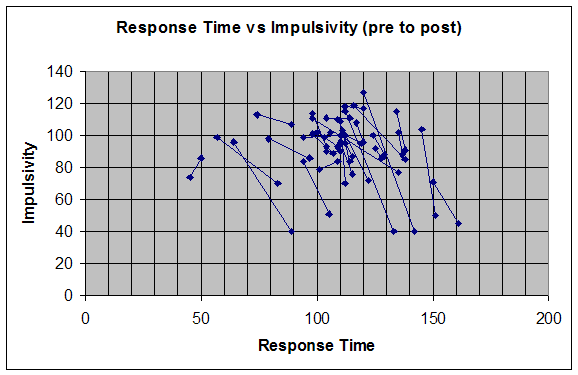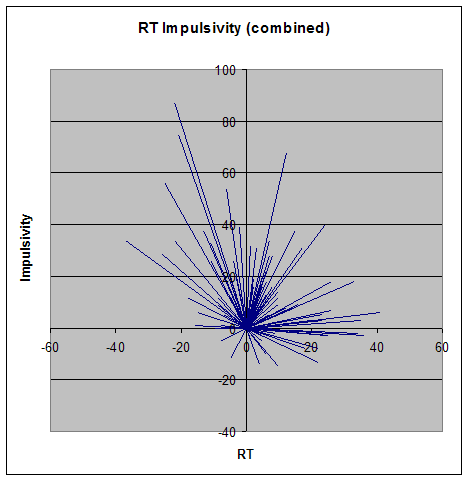A Critical Appraisal of Inter-Hemispheric Training
by Siegfried Othmer | November 24th, 2005In newsletters #40 and #41 we showed cumulative data on clients for whom the dominant protocol consisted of inter-hemispheric training with single-channel bipolar placement. The results have proved to be generally better than what we were able to do with our prior lateralized placements. The reality is even more compelling than what is shown by the data, for two reasons that have been previously mentioned: 1) the clinical populations are much more challenging now than they were a decade ago; and 2) more of these difficult clients are brought successfully to the point of re-testing, so that they actually appear in the data set. Dropouts from training were more commonplace years ago, particularly of course among those for whom our conventional ministrations were not the appropriate remedy.
With this state of affairs as a background, the bar is inevitably raised (in our heart of hearts if nowhere else) for expectations that we hold for new cases coming in the door. Increasingly, there is a fairly established expectation of some significant clinical success for what has become an inclusive set of clinical challenges. It has reached the point where we might hold out the eventual goal of “zero-defect neurofeedback,” the expectation that we can through neurofeedback move nearly everyone to a more functional place, and more particularly, come close to having the assurance that no one will be worse off for the experience. Even if the initial experience with neurofeedback were to be negative in a particular case, protocols exist that would allow recovery. These protocols aren’t just postulated to exist in principle–we actually believe that we know what they are. So, given the opportunity, we should be in a position to benefit nearly everyone who comes for our services with the relevant clinical complaints.
So the question of the hour is whether we can consult our recent clinical history and verify that essentially everyone in the database did in fact benefit significantly from the experience, and more particularly did not get worse. This will help to answer our critics who reacted to the suggestion of inter-hemispheric training with great skepticism and suspicion. In particular, the reinforcement of low EEG frequencies was thought to be a bad idea. At our present state of knowledge, it is already clear that the inter-hemispheric training protocols we employ do not constitute a “complete set” in the above sense that everyone gets better and no one gets worse. For a good many people, we end up migrating to lateralized trainings to optimize the response. Nevertheless, the inter-hemispheric protocols continue to dominate, so that is what the discussion is essentially about.
Our vehicle is once again the TOVA data, firstly because it is plentiful and secondly because it is so rich in insights about consistency in one key domain of neurophysiological functioning. In our critical survey of the data, we observe that our consistency in improving TOVA scores is much more limited when it comes to reaction time than for omission and commission errors. Are we dealing here with a regression to the mean? Is it a matter of a change in test-taking strategy? Are some people enabled for the first time to systematically make more deliberate decisions? Are some people just becoming more averse to making impulsive errors, while at the same time being enabled to actually withhold their “automatic” response? Or would a different neurofeedback strategy have led to a more satisfactory outcome? It may turn out to be difficult to find our way to a definitive and comprehensive answer.
The matter of reaction time is a good area on which to focus because our clients would generally regard an increase in average reaction time as a down-side. One fellow turned neurofeedback down in the California prison system on the mere suspicion that the training might slow his reaction time. The concern that the training might slow them down comes right after the one that the training might make them stupid. We begin by recalling the reaction time data.

Some decreases in reaction time standard score are observed. Most of these are for starting values greater than 100. We have selected all those cases that show decrease in reaction time standard score in Figure 2. (So time flows to the left in that chart.) A total of 31 cases were thus identified, out of the total set of 106. Of these 25 improved in impulsivity standard score (81%); two worsened, and four were unchanged. So it is apparent that worsening of reaction time standard score is highly correlated with improvement in impulsivity. Perhaps this is just a “price on has to pay” for improved performance on commission errors. Keith Conners certainly considers extremely short reaction times to be a deficit, and would therefore not see “regression to the mean” here as a problem. But we also know of high performance sports people who were capable of error-free performance with extremely short reaction times.

It is quite clear by now that the choice TOVA people made to regard anything less than a 200msec reaction time as an anticipatory response was in considerable error. We see people routinely who “beat” the 200msec barrier and still respond accurately. Barry Sterman reported the same phenomenon for his B-2 pilots. And Leslie Coates worked for a while with one of the top hitters in professional baseball who routinely beat the TOVA.
On the other hand, the best performance of which humankind is capable may not be within reach for every nervous system. The fact that an increase in reaction time is so commonplace in this data set tempts one to suppose that the trend is not an abnormal one, an index to treatment failure. Of the 75 people (out of 106) who improved their impulsivity score, 61 also improved their reaction time score (81%); 13 worsened their reaction time score (17%), and one showed no change.
The entire data set is replotted in Figure 3 to show the relationship between change in impulsivity and reaction time generally. Reaction time standard score is plotted horizontally, versus impulsivity standard score vertically. With respect to the minimal success criterion that improvement be manifested in either impulsivity or reaction time, or both, we observe that out of the entire data set of 106 there are only two exceptions, showing up in the bottom left quadrant. Both of these vector lengths are quite short; in fact, they are within test-retest error of half a standard deviation. So with respect to the objective of not making anyone worse, we appear to have succeeded, and the concerns about inter-hemispheric training in this regard appear to be misplaced.

One significant shortcoming of the above analysis is that it refers entirely to 20-session retest data. That is not usually the end of the story, particularly with the more challenging clinical population we are now concerned with. On the other hand, we have the advantage here of a larger data set. Some clients depart without a final retest, and a number now head home with remote-use instruments, so we do not always get to calibrate the end-point of training. One principal rationale for the 20-session retest is to trigger a reappraisal of the protocol choices, and the data cannot reflect the benefit of that.
We now advise the more functional of our clients that they may anticipate an improvement in their reaction time along with the calming of their impulsivity, in accord with our observations. For the more severely deficited population, the pre-training measures may reflect more of a pure reaction time, and the post-training measure a more appropriate choice reaction time. Of necessity, the latter will be somewhat greater. This means that the fast reaction time population is actually a “salt-and-pepper” mix of the high performers along with of some of the most disregulated. The high performers continue to improve in reaction time. As for the latter, a regression toward the reaction time mean is not surprising.
In summary, the data do not support the original concern that inter-hemispheric training may be contra-indicated when conducted with low-frequency rewards. If there is a concern about “negative” outcomes, it is likely to lodge on the matter of reaction time, and we observe that there are a number of benign explanations for the reaction time data. Significantly, there is no evidence that anyone’s performance gets significantly worse for the effort.
Acknowledgements: I thank John Putman for the analysis of the data, and for our joint discussions of the implications.





